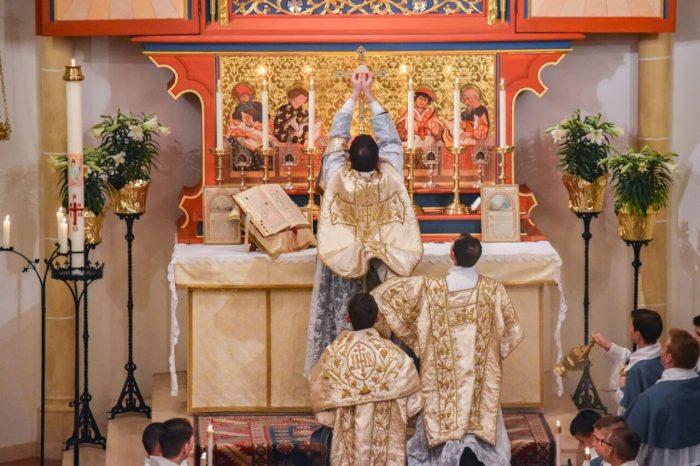Jeg fikk i dag et spørsmål fra en leser angående påskevigiliens liturgi: «Iår fulgte jeg triduum på to nettsteder: FSSP fra Fribourg og SSPX fra Zaitkofen, og ble forundret over at mens man i SSPX fulgte Pius XIIs “nye” litugi for påskenatt, feiret man i FSSP den gamle fra før 1955. Vet moderator noe om bakgrunnen herfor? Lesningene i den eldste variant tok fryktelig lang tid, så i pedagogisk henseende må den “nye” være mye bedre egnet i en sognekirke – men hvilken er den den historisk sett mest “korrekte”?»
Jeg kan gi to korte svar på dette spørsmålet: 1) Det opprinnelige tidspunktet for å feire påskevigilien var utvilsom kvelden/natten før påskedag, og så ble dette gradvis flyttet til lørdag formiddag – den ble feiret så tidlig i flere hundre år før 1955. (Liturgien var også så lang at det i liten grad passet for hele menigheten, som det blir påpekt.) Catholic Encyclopedia skriver om dette, bl.a.
In the primitive Church Holy Saturday was known as Great, or Grand, Saturday, Holy Saturday, the Angelic Night, the Vigil of Easter, etc. It is no longer, like Maundy Thursday, a day of joy, but one of joy and sadness intermingled; it is the close of the season of Lent and penance, and the beginning of paschal time, which is one of rejoicing.
By a noteworthy exception, in the early Church this was the only Saturday on which fasting was permitted (Constit. Apost., VII, 23), and the fast was one of special severity. Dating from the time of St. Irenaeus, an absolute fast from every kind of food was observed for the forty hours preceding the feast of Easter, and although the moment assigned for breaking the fast at dawn on Sunday varied according to time and country, the abstinence from food on Holy Saturday was general.
The night of the vigil of Easter has undergone a strange displacement. During the first six or seven centuries, ceremonies were in progress throughout the entire night, so that the Alleluia coincided with the day and moment of the Resurrection. In the eighth century these same ceremonies were held on Saturday afternoon and, by a singular anachronism, were later on conducted on Saturday morning, thus the time for carrying out the solemnity was advanced almost a whole day. Thanks to this change, special services were now assigned to Holy Saturday whereas, beforehand, it had had none until the late hour of the vigil.
2) Om innholdet i påskevigilien fra 1955 eller 1969 er særlig opprinnelig er et annet spørsmål; sannsynligvis er den ikke det, den er vel heller et uttrykk for den liturgiske bevegelses arkeologisme (reformen i 1955 er første eksempel på dette).
New Liturgical Movedment har flere artikler om hvordan påskevigilien ble gjennomført før reformen i 1955; se nr. 1 HER og nr. 2 HER, skrevet av Gregory DiPippo.
Peter Kwasniewski har skrevet om sitt første møte med den stille ukes gamle [før 1955] seremonier (i 2019) og han oppsummerer sin opplevelse av påskevigilien slik:
The whole Vigil liturgy — one vast hymn of praise to the might of God revealed in the creation of the world, the creation of the old Israel, and the creation of the new Israel — possessed a cosmic sweep, a historical rootedness, and an immersion into mystery that I have never seen before, in a seamless interconnection that had none of those embarrassing modular joints or ceremonial caesuras typical of the work of Vatican committees from 1948 onward.
There is no doubt in my mind that the pre-1955 Easter Vigil is the crown jewel of the Tridentine rite and that we must do everything we can to recover it. I am also, again as with Palm Sunday, speechless that any reformers could dare to take away something like this.
A priest who has celebrated both forms of Holy Week (the pre-’55 and the ’55) told me recently: “The old liturgical rites drive home the integral and essential connection between the sacrifice of the Cross and the Eucharistic sacrifice. The new [Pacellian] versions systematically downplay this. The old liturgies are coherent in what they contain and when they present it; the new versions are piecemeal and chaotic. In fact, some of the same people who worked on the ‘renewed’ Holy Week later worked on the Novus Ordo, and when they got around to fixing some of the problems they themselves had introduced, they blamed the problems not on their bungling of the work, but on the ‘old liturgy’! How’s that for mendacious?” …
3) Til slutt kan jeg ikke si noe annet om hvorfor SSPX brukte 1962-liturgien og FSSP brukte liturgien fra før 1955, enn at det i de aller siste årene gradvis har vokst frem en interesse for liturgien før 1962 – og den stille ukes liturgi var egentlig det eneste som hadde blitt reformert før 1962. Kanskje andre kan svare bedre på dette spørsmålet?


Mange takk for grundig svar!